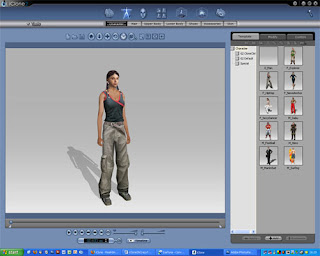2D Animation
2D animation is simply making objects move in a two dimensional space. These objects vary from stills, like photographs or logos to more complex objects, like 3D graphics. We can treat video like a graphic element and animate it the same way in creating layering effects. Once imported to our software, we can order the layering and apply a plethora of filtered effects. We use the latest versions of Photoshop, Illustrator, Freehand, After Affects, Motion, Live Type, and Maya, in Design, Aperture, Shake and Flash
.
.
Animation is the rapid display of a sequence of images of 2-D or 3-D artwork or model positions in order to create an illusion of movement. It is an optical illusion of motion due to the phenomenon of persistence of vision, and can be created and demonstrated in a number of ways. .
3D Animation
 These animations are made using a variety of techniques such as modeling in clay and plasticine or puppets. 3D animations can also be made using computer software to create three-dimensional characters and scenery. ...
These animations are made using a variety of techniques such as modeling in clay and plasticine or puppets. 3D animations can also be made using computer software to create three-dimensional characters and scenery. ...Despite these differences, 3D computer graphics rely on many of the same algorithms as 2D computer vector graphics in the wire-frame model and 2D computer raster graphics in the final rendered display. In computer graphics software, the distinction between 2D and 3D is occasionally blurred; 2D applications may use 3D techniques to achieve effects such as lighting, and 3D may use 2D rendering techniques.
What is the difference between 2D and 3D?
 |
| 2D Animation |
2D and 3D refer to the actual dimensions in a computer's workspace. 2D is 'flat', using the X & Y (horizontal and vertical) axis', the image has only two dimensions and if turned to the side becomes a line. 3D adds the 'Z' dimension. This third dimension allows for rotation and depth. It's essentially the difference between apainting and a sculpture.
The most familiar form of 2D animations can be found by watching Saturday morning cartoonswith your kids, or even simpler animations every day when you surf the web. It takes on theforms of advertisements, e-cards, etc. The basic starting point for all animations is a storyboard that lays out the basic script in a visual format, much like an extra large comic strip.
 |
| 3D Animation |
From that point a rough audio track of the script is created to give animators something to sync with their drawings. This form of animation uses "vector graphics," meaning that the images are based upon mathematical equations, rather than by an array of pixels, such as in "raster graphics."
 Although similar in some ways to 2D animations, 3D computer animation is a different process, as a scene being done in 3D is created long before any actual animation begins. Even in general terms, most people automatically think 3D when they are speaking or reading about computer animation, partly due to its flexibility. What many people do not realize is that the entertainment industry and specifically motion picture applications, while possibly being the forerunners in advancing technologies, only account for a fraction of the 3D animations market. Actually, there is very little difference between computer animation and what is called traditional animation.
Although similar in some ways to 2D animations, 3D computer animation is a different process, as a scene being done in 3D is created long before any actual animation begins. Even in general terms, most people automatically think 3D when they are speaking or reading about computer animation, partly due to its flexibility. What many people do not realize is that the entertainment industry and specifically motion picture applications, while possibly being the forerunners in advancing technologies, only account for a fraction of the 3D animations market. Actually, there is very little difference between computer animation and what is called traditional animation. Many animations can be created completely on a computer, but depending on the type of animation desired, such as cartoon animations, there may be the need for some hand-penciling work to be done.
2D and 3D Animation Basics
• 2D Animation. 2D software uses images called bitmaps that consist of blocks of color stacked together to make a picture. The limitation is that only one angle can be seen at any given time.
• 3D Animation. 3D software uses computer-generated lines, surfaces, or solids to create 3 dimensional models. It is also a more difficult technique to perfect.
• What It Means. While 3D animation gives a better image, cost and time constraints make 2D techniques a bit more attractive for most budgets


nice
ReplyDelete2d animation